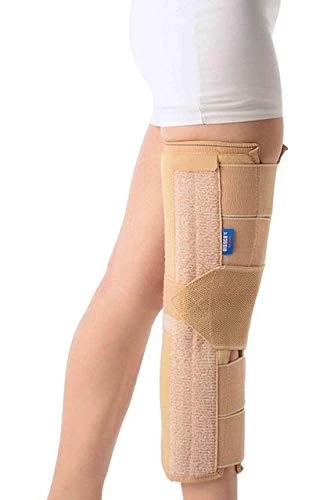The knee is kept stable by removable devices referred to as knee immobilisers. Knee immobilisers are routinely utilised for injuries that benefit from immobilisation but tolerate brief periods without immobilisation and do not require casting.
Your knee's structures could be damaged or dislocated in the event of an accident or fall, necessitating the usage of a knee immobiliser while you recover. Your healthy knee joint could be harmed by a harsh impact while participating in sports. Due to an underlying condition, the knee may also be more vulnerable to damage.
Its construction typically comprises a thick, cotton, foam-wrapped mid-calf to mid-thigh wrap. Due to its size, the wrap provides support, and many straps keep it in place. Stability is increased by removable stiff strips fastened to the apparatus's medial and lateral sides using hook-and-loop connections.
Three types of knee immobilisers are available that provide structural support:
Functional Immobiliser: Studies have demonstrated that these braces enhance stability and protection to the injured knee.
Immobilisers For Rehabilitation: These limit the knee's range of motion as it recovers from an injury or surgery.
Prophylactic Immobilisers: These are designed to prevent knee injury when participating in contact sports.
Choosing the right immobiliser to wear and getting a good fit is essential to attaining the benefits you seek and ensuring that it is as comfortable (and effective) as feasible. When considering whether to wear structural knee support, one should take the following factors into account:
Which ligaments specifically are impactedWhat medical care you have received or desireThe activity you are performingYou will receive guidance on the type of support you need and how to use it from your physician or physical therapist. Additionally, they can determine whether any adjustments or a new size are necessarily based on how well your immobiliser fits.
When To Wear Knee Immobilisers
Wearing your immobilisers can be helpful when you think you need them and when they are most likely helpful. Wearing your immobiliser may be required throughout the day or during specific activities. Wearing it too much or not enough can cause issues.
Removing your immobilisers before your knee joint is ready could hurt your recovery. A knee injury could also happen from not wearing it when you are in danger. If you're unsure about whether you should wear your immobilisers while:
SleepingSittingDrivingWalkingStretchingKnee immobilisers can provide discomfort relief and protection for your knee in various circumstances. It's essential to use your immobiliser correctly to gain the most benefit from it, and you should keep your doctor or physical therapist informed of any changes in your body's demands. Visit Vissco Next.


